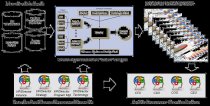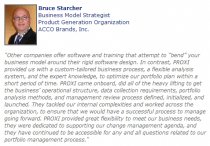PROXI management decisions

A Proven Process to Meet Your Decision Needs
Management leaders have a universal need to allocate time, people, and money to the “best” set of project investments. Executive teams must continually decide how to invest finite resources to produce the optimal performance outcomes for their stakeholders.
The process of evaluating and making such decisions has remarkably consistent inputs, analysis requirements, and planning outputs, across companies, industries, and global geographies.
 That being said, the measurement of “best” performance, the relevant resource and strategic constraints, and the risk tolerances of interest vary greatly across organizations.
That being said, the measurement of “best” performance, the relevant resource and strategic constraints, and the risk tolerances of interest vary greatly across organizations.
We reflect these organization-specific issues into a process architecture that utilizes the necessary business-case inputs, that reconciles project resource requirements with organizational capacities, and that offers the desired strategy and risk analysis levers to explore all optimal investment scenarios available (this generalized architecture is depicted below).
Your Process Must Be Built On An Organization-specific Business-case
The foundation for any rigorous portfolio management methodology is a high-integrity, project-level business case. The business case must be structured with upfront insights about what value creation metrics will be calculated, how project costs and benefits will be forecasted, at what level resource and budget constraints will be enforced, and which strategic and risk criteria will be used to execute strategy and to diversify risk.
The business case determines what data must be collected to “feed” the portfolio planning process and what analytical capabilities will be enabled for “what-if” scenario analysis. Only after the specific business-case content and level of detail is established, can an organization’s data readiness and completeness be assessed. In most cases, the requisite data exists in various enterprise repositories and/or spreadsheets. However, there can be issues with missing data for some projects, data that needs to be transformed into a different format or unit of measure, or data that is not readily accessible for supporting a robust process.
The most common steps to achieving a fully-integrated, multi-criteria portfolio analysis process are represented in the figure below. Although Data Preparation is depicted as the first step (leftmost column), the Business Case step is actually the most frequent process development starting point.


You might also like


Wealth Adviser: Turn Office Assistants into Prospectors — Wall Street Journal
“I had grown weary of upper management making decisions for client-facing advisors pertaining to the tools used and the manner of serving clients,” he writes on ThinkAdvisor.

|
Navigating by COMPASS: Corporate matrix portfolio analysis support system (Decision making and operations management series) Book (Boyd & Fraser)
|




